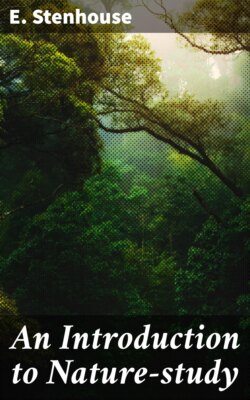Читать книгу An Introduction to Nature-study - E. Stenhouse - Страница 7
На сайте Литреса книга снята с продажи.
4. THE EARLY STAGES OF GROWTH OF
MAIZE AND WHEAT.
Оглавление1. The roots.—Watch for the appearance of the roots. Is there, as in the seedlings previously studied, one principal root, or are there soon several, all apparently of equal or nearly equal importance? Do the roots grow straight down as before, or do they spread horizontally?
2. The stem and the cotyledon.—Notice that a rod, somewhat thicker than a root, grows out near the origin of the roots, and curves upwards towards the light. When this is about an inch long on a maize seedling, slit it open carefully, and observe that it consists of a pale outer sheath and a green core. The sheath is the single cotyledon; the green core is the young stem enclosed in a young foliage leaf. Cut open the grain and notice how the endosperm has shrivelled. As the seedlings become larger watch the young stem growing out at the end of its sheathing cotyledon. What is the length of the cotyledon when the stem first appears (a) in the maize, (b) in the wheat?
3. The foliage leaves.—As soon as a foliage leaf unfolds make a drawing of its shape. Contrast it with the young foliage leaves of the other seedlings. Hold up the leaves to the light and compare the arrangement of their veins.
How maize and wheat seeds grow.—When the maize and wheat fruits have been kept in damp sawdust for a few days, the seeds—one in each fruit—begin to germinate. As a rule the wheat plants have grown to a height of some inches before the roots and stems of the maize plant have emerged from the seeds.
The roots.—As might be expected, the first signs of life make their appearance at the white scar which indicates the position of the embryo or young plant. Instead of one main root growing out, several little roots make their appearance almost at the same time. They do not grow as directly downwards as the radicle of a pea or bean (Fig. 6), but tend to spread in a horizontal direction (Fig. 17). It is clear that in this way the roots are more independent of each other than if they grew directly downward side by side.
The cotyledon and the stem.—Growing out from the seed close to the roots is another rod (Fig. 17, C), rather thicker than the roots, which at once curves upwards to the light. It is pale green in colour. This is the cotyledon or first leaf. When it is carefully slit open, it is found to be a hollow sheath, enclosing a bright green core. In the seedlings which are left undisturbed, the core at last breaks through the tip of the cotyledon. It consists of the young stem and its surrounding foliage leaves. As the growth of the plant continues, these sheathing leaves unfold themselves into the long narrow blades characteristic of grass leaves (Fig. 98). The bottom of each leaf is tubular and forms a sheath round the stem.
